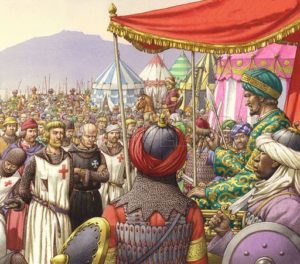1187
The True Cross is lost
The knights of the First Crusade captured Jerusalem in 1099 and went on to establish four states on the eastern coast of the Mediterranean. The County of Edessa, the Principality of Antioch, the County of Tripoli and the Kingdom of Jerusalem were precarious Roman Catholic, feudal outposts in an alien landscape. Their subjects were mainly Eastern Christians of one sort or another and Muslims; their neighbours were hostile Islamic powers. The First Crusade had arrived at a time of Muslim disunity but would soon face a stronger and more united set of enemies. Edessa fell in 1144 and the Second Crusade failed to recover it. By the 1180s the great Saladin was the sultan of a great swath of territory surrounding the crusader states and he was determined to bring them down.
The Kingdom of Jerusalem was an elective monarchy, dependent on the armies of quarrelling barons and the fighting monks of the Knights Templar and Hospitallers. In 1186 the hapless Guy de Lusignan (1150-94) became King. A weak man, he was bullied into leading an army against Saladin the following year rather than relying on the strength of the crusader castles to sap the sultan’s strength. Trapped in the desert, far from water, at a location known as the Horns of Hattin the Christian army was soundly defeated by Saladin. Though Guy was spared, most of the prisoners, including all of the Templars and Hospitallers were massacred. A Muslim observer described the scene:
Saladin ordered that they should be beheaded, choosing to have them dead rather than in prison. With him was a whole band of scholars and sufis and a certain number of devout men and ascetics, each begged to be allowed to kill one of them, and drew his sword and rolled back his sleeve. Saladin, his face joyful, was sitting on his dais, the unbelievers showed black despair.
Guy was taken in golden chains as prisoner to Damascus. The True Cross, Christendom’s holiest relic which was always carried in front of the Kingdom of Jerusalem’s armies, was paraded before jubilant Muslim crowds and then disappears from history. Many crusader castles which had been stripped of troops for Guy’s armies soon fell to Saladin and Jerusalem itself was captured. This calamity promoted the Third Crusade which, though it recovered some of the lost territory, was never able to retake Jerusalem.
Guy, after being released by Saladin, was given Cyprus as a consolation prize — the island had been captured from the Byzantines by Richard Coeur de Lion of England. The Kingdom of Jerusalem continued to cling to a strip of coastal cities until the last stronghold fell in 1291. The title of King of Jerusalem continued to be claimed by many European royal houses in France, Spain, Germany and Italy and today the strongest claimant is likely Philip VI of Spain.
